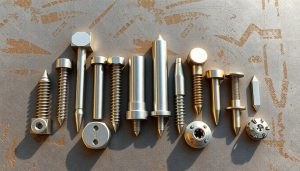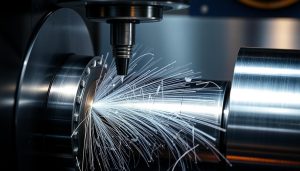Spot welding is a widely used resistance welding technique that is crucial in the manufacturing industry, particularly in the automotive and appliance sectors. This process involves applying localized heat, pressure, and electric current to join thin metal sheets at specific points, creating strong, durable bonds. The spot welding process is known for its speed, efficiency, and cost-effectiveness, making it a preferred choice for mass production of metal components.
The Basics of Spot Welding
Spot welding is a highly efficient and widely used joining technique in various industries. To understand the mechanics of this process, it’s crucial to explore the fundamental components involved. At the heart of spot welding lies the electrode tips, which act as the conduits for the electric current, transferring the necessary heat to the metal sheets. Powering this process is the welding transformer, responsible for converting the incoming electricity into the precise voltage and current required for the weld.
How Does Spot Welding Work?
The spot welding process works by passing a high electric current through two or more metal sheets at the point of contact. This surge of electricity generates intense heat, causing the metal to melt and fuse together, creating a strong, localized bond. The pressure mechanism, another essential component, applies a controlled force to the electrode tips, ensuring the metal sheets are held firmly in place during the welding process.
Components Involved in Spot Welding
- Electrode Tips: These crucial components conduct the electric current and transfer the heat to the metal sheets, enabling the welding process.
- Welding Transformer: This device transforms the incoming electricity into the specific voltage and current required for spot welding.
- Pressure Mechanism: The pressure mechanism applies a controlled force to the electrode tips, holding the metal sheets firmly in place during the welding process.
Understanding the basics of how spot welding works and the key components involved is essential for effective implementation of this versatile joining technique. By mastering these fundamentals, you can ensure the successful and efficient execution of spot welding in a variety of applications.
Spot Welding Process Steps
The spot welding process involves several critical steps, each playing a vital role in creating strong, durable welds across various manufacturing applications. Let’s explore the key stages of this precision metal joining technique.
Preparing the Metal Sheets
The first step in the spot welding process is thorough metal preparation. This involves cleaning the surfaces of the metal sheets to remove any dirt, grease, or oxides that could interfere with the welding process. Proper metal preparation ensures optimal weld nugget formation and a secure bond between the workpieces.
Applying Pressure and Electric Current
Once the metal sheets are properly prepared, the spot welding machine applies a controlled amount of pressure and an electric current to the contact point between the sheets. The intense heat generated by the electric current melts the metal, creating a weld nugget that fuses the two pieces together.
Cooling and Final Bonding
The final step in the spot welding process is the cooling phase, where the weld nugget solidifies, forming a strong, permanent bond between the metal sheets. This cooling process is critical for ensuring the structural integrity of the joint and preventing any distortion or warping of the materials.

“The spot welding process is a highly efficient and cost-effective method for joining thin sheet metals, making it an essential technique in various manufacturing industries.”
Advantages of Spot Welding
Spot welding is a highly versatile and efficient joining technique that has gained widespread popularity across various manufacturing industries. Its key advantages make it a preferred choice for rapid welding, cost-efficient joining, and creating high-strength joints with minimal material distortion.
Speed and Efficiency in Mass Production
One of the primary advantages of spot welding is its exceptional speed and efficiency in mass production scenarios. The process is highly automated, allowing for rapid welding cycles that can significantly increase output and productivity. This makes spot welding an ideal choice for industries like automotive manufacturing, where high-volume production is essential.
Cost-Effectiveness for Thin Sheet Metals
Spot welding is particularly cost-effective when working with thin sheet metals, which are commonly used in industries such as electronics and appliance manufacturing. The process requires minimal material input and generates little waste, making it a cost-efficient joining solution compared to other welding methods.
High-Strength Joints with Minimal Material Deformation
Spot welding’s unique ability to create high-strength joints with minimal distortion is another key advantage. The localized application of heat and pressure in the welding process helps to preserve the structural integrity of the metal, resulting in rapid welding of components without significant warping or deformation.
“Spot welding is an excellent choice for manufacturing applications that demand a balance of speed, cost-efficiency, and structural integrity.”
These advantages make spot welding a versatile and valuable tool in the manufacturing industry, allowing businesses to enhance productivity, reduce costs, and deliver high-quality products with precision.

Applications of Spot Welding
Spot welding finds extensive use in various industries, showcasing its versatility and efficiency. From the automotive sector to electronics and appliance manufacturing, this welding technique plays a crucial role in shaping modern manufacturing processes.
Automotive Industry: Manufacturing Car Bodies
In the automotive industry, spot welding is an indispensable tool for car body assembly. It allows manufacturers to quickly and precisely join thin metal sheets, creating the sturdy and lightweight structures that define the vehicles we drive. The speed and precision of automotive welding processes enabled by spot welding are essential for meeting the demands of high-volume production.
Electronics Industry: Connecting Thin Metal Components
The electronics industry heavily relies on spot welding for connecting thin metal components. From the intricate circuitry of smartphones to the intricate assemblies of laptops and other digital devices, electronic component assembly often requires the secure and efficient bonding that spot welding provides. This welding technique ensures a strong, reliable connection while minimizing material distortion.
Appliance Manufacturing: High-Volume Production of Household Items
Spot welding also plays a crucial role in the appliance manufacturing industry. Household items such as washing machines, refrigerators, and ovens require high-volume production with consistently strong and durable joints. Spot welding enables manufacturers to efficiently assemble these complex appliances, ensuring quality and reliability in every piece.
“Spot welding has revolutionized the way we manufacture critical components across multiple industries, from the cars we drive to the appliances that power our homes.”
| Industry | Application | Benefit of Spot Welding |
|---|---|---|
| Automotive | Car Body Assembly | Speed and precision for high-volume production |
| Electronics | Connecting Thin Metal Components | Secure bonding with minimal material distortion |
| Appliance Manufacturing | High-Volume Production of Household Items | Efficient assembly with consistently strong and durable joints |
Spot Welding vs Other Welding Methods
When it comes to joining sheet metal components, spot welding stands out as a highly efficient and versatile technique. Compared to other popular welding methods like MIG welding and TIG welding, spot welding offers unique advantages that make it a preferred choice for a wide range of industries.
Comparison with MIG and TIG Welding
While MIG welding and TIG welding excel in creating strong, continuous welds, spot welding is specifically designed for sheet metal applications. It delivers speed, precision, and cost-effectiveness that make it an ideal solution for high-volume production scenarios.
- Spot welding is faster and more efficient, allowing for rapid joining of metal sheets with minimal material deformation.
- MIG welding and TIG welding are better suited for thicker materials and more complex fabrication tasks, but can be more time-consuming and labor-intensive.
- Spot welding is a highly automated process, making it a cost-effective choice for mass production environments, while the other methods often require more manual labor.
Benefits of Spot Welding for Sheet Metal
The unique characteristics of spot welding make it a standout choice for sheet metal applications, particularly in industries like automotive, electronics, and appliance manufacturing.
- Speed and Precision: The rapid application of heat and pressure allows for quick, accurate welds without excessive material deformation.
- Cost-Effectiveness: The automated nature of spot welding, combined with its suitability for thin materials, makes it a cost-efficient solution for high-volume production.
- Strength and Durability: Spot welding creates strong, durable joints that can withstand the rigors of everyday use in a wide range of products.
By understanding the unique advantages of spot welding, manufacturers can leverage this versatile technique to enhance the quality, efficiency, and cost-effectiveness of their sheet metal fabrication processes.
Why Choose Shixinproto’s Spot Welding Services?
When it comes to professional spot welding services, Shixinproto stands out as a trusted industry leader. Their state-of-the-art equipment and skilled technicians ensure high-quality, consistent welds across a variety of industries. Manufacturers seeking reliable and cost-effective spot welding solutions can rely on Shixinproto to deliver efficient and innovative spot welding services.
Shixinproto’s commitment to quality is evident in every aspect of their work. Their team of experienced welding experts utilizes advanced techniques and cutting-edge technology to provide manufacturers with the precise and durable spot welds they require. Whether you’re in the automotive, electronics, or appliance industry, Shixinproto’s quality welding solutions can help you meet your production goals with ease.
With Shixinproto, you can rest assured that your spot welding needs will be handled with the utmost care and attention to detail. Their customer-centric approach and unwavering dedication to excellence make them the ideal partner for businesses seeking professional spot welding services that deliver exceptional results. Trust Shixinproto to elevate your manufacturing processes and take your spot welding quality to new heights.





